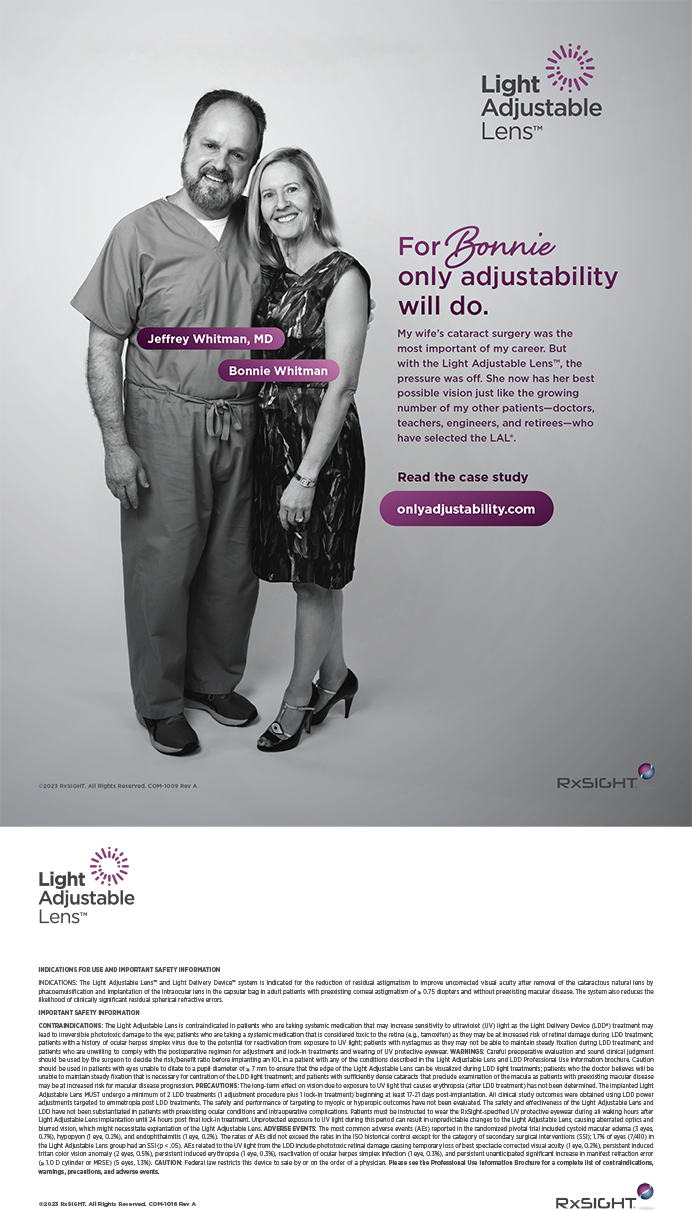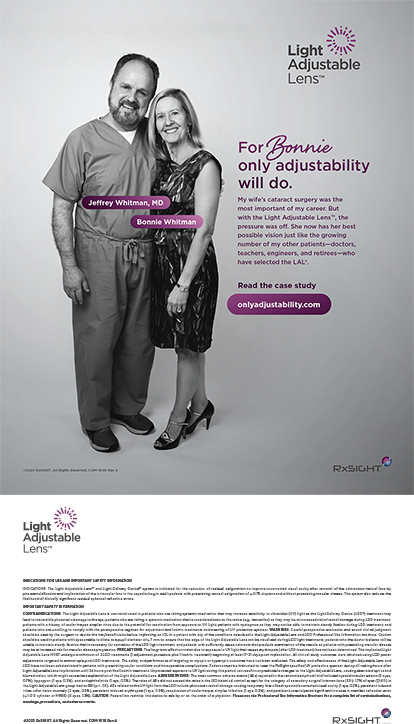CASE PRESENTATION
An 80-year-old man is brought to your practice by his daughter after the nursing home's staff noticed a change in the “color” of his left eye. The patient has moderate to severe Alzheimer disease and requires assistance for dressing and feeding himself.
His BCVA is estimated at 20/200 OD and light perception OS. His right eye has mild phacodonesis and a 3+ to 4+ nuclear sclerotic cataract. His left eye has a dislocated white cataract in the anterior chamber (Figure). Tonometry readings are 18 mm Hg OU. The corneas are clear and compact. There is rare anterior chamber cell in the left eye. A posterior view of the left eye shows an atrophic optic nerve.
How do you address advanced cataracts in patients with Alzheimer disease? How would you approach this patient's left eye?
LISA BROTHERS ARBISER, MD
No matter the mental status of the patient, significant visual improvement can improve his or her daily function and, rarely, even affect his or her level of mental alertness. Given normal zonular support, if general anesthesia is required due to mentation and there are profound bilateral cataracts present, I plan to perform immediate bilateral sequential cataract surgery with one anesthesia. I prefer a posterior continuous curvilinear capsulorhexis to maintain the integrity of the anterior hyaloid membrane. I capture the optic of a three-piece lens such that its haptics are in the bag and the optic is in Berger's space (buttonhole technique). This limits the surgical events to one, preventing any possibility of future opacification of the visual axis in someone who cannot sit for a YAG capsulotomy.
The presented case is different due to the dislocated cataract with optic atrophy and phacodonesis. No mention is made of a relative afferent pupillary defect in the patient's left eye, but I assume it, given the optic atrophy. In all likelihood, a dilated aphakic refraction would show no central visual acuity, and there would be faulty light projection. If so, functional visual potential is poor, and I would not operate on the patient's left eye at all, so long as there is no pain, inflammation, or glaucoma, as evidenced by the figure. Moreover, this completely subluxated hypermature lens would necessitate an intracapsular approach. The large incision thus required would be a managerial problem, given the patient's Alzheimer disease, with little to no upside for the patient's quality of life.
I would instead plan general anesthesia for an operation on his legally blind but better-seeing right eye. Because there is frank phacodonesis and the fellow eye's lens has dislocated, I would anticipate needing capsular hooks intraoperatively to allow the placement of either a Cionni Ring for Sclera Fixation or a standard capsular tension ring with an Ahmed Capsular Tension Segment (Cionni and Ahmed devices manufactured by Morcher GmbH and distributed in the United States by FCI Ophthalmics, Inc.). I would employ 8–0 Gore-Tex sutures (W.L. Gore & Associates, Inc.; off-label use) with an ab externo technique. In my experience, this approach maintains a twochambered eye; promotes rapid visual recovery with a standard, sutureless incision; and, being pain-free, is generally not a managerial problem in the mentally challenged.
GEORGE BEIKO, BM, BCh, FRCSC
Visually disabling cataracts (visual acuity of 20/200 or less) in patients with Alzheimer disease add to their confusion and decrease their ability to function. In a significant number of my patients with Alzheimer disease, cataract surgery has improved their quality of life and even provided them with some independence. I therefore advocate for the surgery in one eye and then assess if an improvement in the patient's daily function has occurred before considering the second eye.
The consequences of a dislocated intumescent cataract are uveitis and glaucoma. Because both can lead to a very painful eye, the decision whether to operate or not in this case is not difficult to make.
Surgery on an individual with moderate to severe Alzheimer disease will likely require general sedation, which may add to his or her confusion postoperatively. This patient would benefit from surgery on both eyes. In order to limit his confusion from general anesthesia, I would perform simultaneous, bilateral cataract surgery. I would use acrylic lenses in case he requires silicone oil in the future. The Sensar (Abbott Medical Optics Inc.) would be my choice, because I find it does not get significant glistenings.
During the procedure, I would use small incisions to prevent postoperative dehiscence of the incision, because this confused patient is likely to rub his eyes. For the left eye, I would isolate the dislocated lens in the anterior chamber with a dispersive ophthalmic viscosurgical device. Next, I would use a technique described by Amar Agarwal, MS, FRCS, FRCOphth—the glued IOL scaffold—which involves the initial insertion and scleral fixation of an IOL with tissue glue (www.youtube.com/watch?v=mEf4bknmSBs). I would then bring down the pupil with acetylcholine (Miochol-E; Bausch + Lomb) or, in the event of traumatic mydriasis, with iris suturing. Finally, I would remove the dislocated lens with phacoemulsification.
I would attempt phacoemulsification on the patient's right eye, which has some degree of phacodonesis, with the goal of proceeding to a primary posterior capsulotomy (thus obviating the need for a capsulotomy later). I would place a three-piece foldable lens in the sulcus, with the optic captured through the posterior capsulotomy. I would again fixate the haptics to the sclera with tissue glue.
All wounds, although small, would be sutured to ensure their integrity and some security if the patient inadvertently rubbed his eyes. Both eyes would receive sub-Tenon injections of a steroid and antibiotics due to the patient's anticipated poor compliance with topical medications postoperatively.
I have employed the Agarwal glued IOL technique for the past 2 years, and I have been very impressed with the stability of the IOL as well as the limited ocular inflammation and irritation.
SANJAY KEDHAR, MD
Cataract surgery should not be discounted as an option simply because of a patient's current mental status. In my experience, a successful cataract procedure in patients with dementia (especially those who are institutionalized) has beneficial effects on their well-being. One important consideration is anesthesia: some patients may be better served by general anesthesia than routine sedation/local approach due to intraoperative problems with cooperation. It is important to discuss with the patient and caregiver postoperative cognitive dysfunction, which can result in temporary or permanent worsening of the dementia.
Regardless of the visual potential of the patient's left eye, the dislocated lens needs to be removed to avoid potential corneal decompensation or glaucoma. Given his age and mental status, a simple approach might be best. I would try to induce miosis with pilocarpine 2% to reduce the risk of posterior dislocation of the lens. I would use a small-incision technique for intracapsular cataract extraction similar to that used for manual extracapsular cataract extraction. Specifically, I would make a shelved frown incision that was 6 to 6.5 mm long and located 1.5 to 2 mm posterior to the limbus, and I would use an irrigating vectis to remove the lens. I would instill a generous amount of viscoelastic to protect the cornea and float the lens in the anterior chamber. An anterior vitrectomy could be performed as necessary. As long as the cornea was not compromised, an ACIOL would be a reasonable choice. Alternatively, a PCIOL could be fixated to the sclera. I prefer using Dr. Agarwal's glued IOL method with Tisseel glue (Baxter Healthcare Corporation). I would suture the incision even if it selfsealed to reduce the risk of rupture in the future.
As an aside, one might consider the possibility that this patient has undiagnosed late-stage syphilis. It would provide a unified diagnosis for the optic nerve atrophy, dislocated crystalline lens, and dementia (possibly misdiagnosed as Alzheimer disease). Serologic testing (including fluorescent treponemal antibody-absorption, rapid plasma reagin, venereal disease research laboratory) would be an easy way to confirm or refute the diagnosis.
Section Editor Bonnie A. Henderson, MD, is a partner in Ophthalmic Consultants of Boston and an assistant clinical professor at Harvard Medical School. Thomas A. Oetting, MS, MD, is a clinical professor at the University of Iowa in Iowa City. Tal Raviv, MD, is an attending cornea and refractive surgeon at the New York Eye and Ear Infirmary and an assistant professor of ophthalmology at New York Medical College in Valhalla. Dr. Raviv may be reached at (212) 448-1005; tal.raviv@nylasereye.com.
Lisa Brothers Arbisser, MD, is in private practice with Eye Surgeons Assoc. PC, located in the Iowa and Illinois Quad Cities. Dr. Arbisser is also an adjunct associate professor at the John A. Moran Eye Center of the University of Utah in Salt Lake City. She acknowledged no financial interest in the products or companies she mentioned. Dr. Arbisser may be reached at (563) 323-2020; drlisa@arbisser.com.
George Beiko, BM, BCh, FRCSC, is an assistant professor of ophthalmology at McMaster University, a lecturer at the University of Toronto, and a private practitioner in St. Catharine's, Ontario, Canada. He receives research support from Abbott Medical Optics Inc. Dr. Beiko may be reached at (905) 687-8322; george.beiko@sympatico.ca.
Sanjay Kedhar, MD, is an assistant professor of ophthalmology at The New York Eye & Ear Infirmary in New York City. He acknowledged no financial interest in the product or company he mentioned. Dr. Kedhar may be reached at (646) 943-7906; skedhar@nyee.edu.




